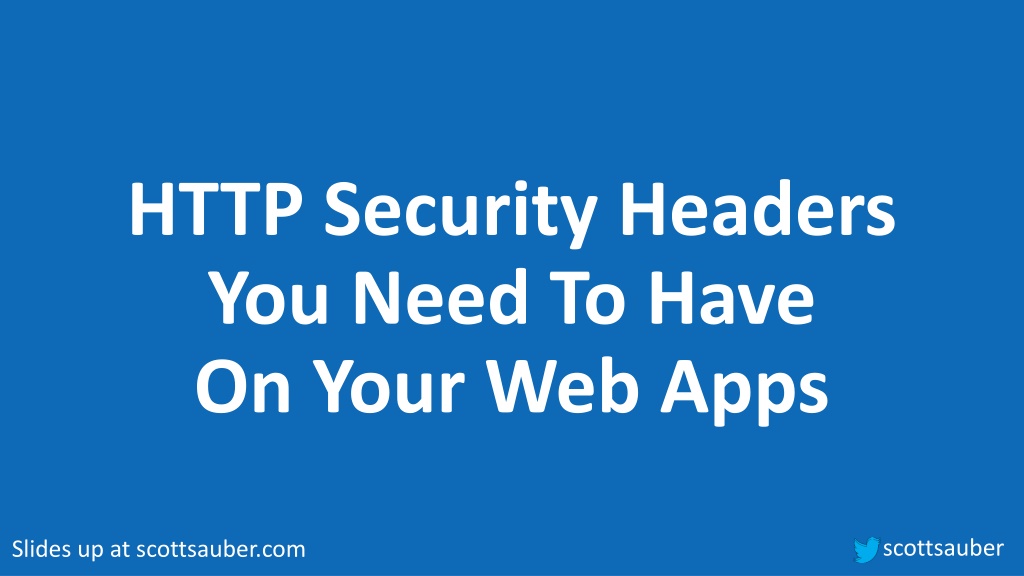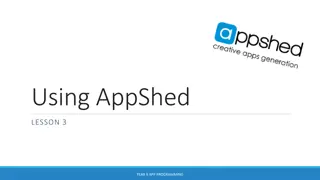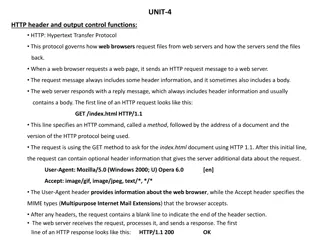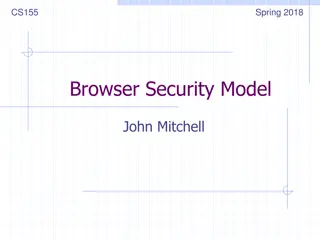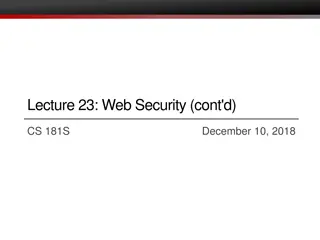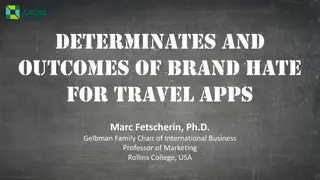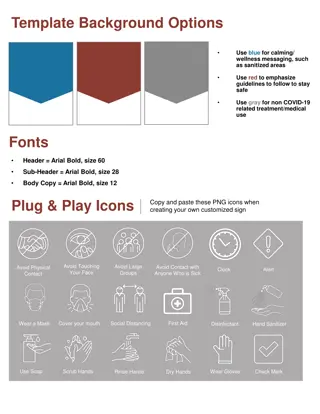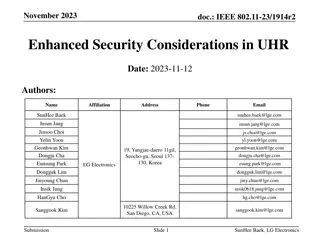Understanding HTTP Security Headers for Web Apps
Explore the importance of HTTP security headers on web applications through a detailed breakdown of headers like HSTS, XFO, XSS, CSP, CTO, RH, and FP. Learn how these headers enhance security by instructing browsers on handling website content, preventing various attacks. Gain insights on configuring security headers for a more secure website. Discover these key components with Scott Sauber's informative slides and delve into the world of web application security. Director of Engineering at Lean TECHniques, Scott Sauber, sheds light on crucial security measures without extensive security expertise.
Uploaded on Oct 04, 2024 | 0 Views
Download Presentation

Please find below an Image/Link to download the presentation.
The content on the website is provided AS IS for your information and personal use only. It may not be sold, licensed, or shared on other websites without obtaining consent from the author. Download presentation by click this link. If you encounter any issues during the download, it is possible that the publisher has removed the file from their server.
E N D
Presentation Transcript
HTTP Security Headers You Need To Have On Your Web Apps scottsauber Slides up at scottsauber.com
Audience Anyone with a web app scottsauber
Agenda What are HTTP Security Headers? Why do they matter? HSTS, XFO, XSS, CSP, CTO, RH, FP What are they What do they do Demo Impact on existing apps scottsauber
Goals Expose you to security headers that are out there Why they are needed Write down ones you need to look into when you re back at work scottsauber
Who am I? Director of Engineering at Lean TECHniques Co-organizer of Iowa .NET User Group Friend of Redgate Blog at scottsauber.com Not a security expert but scottsauber
What are HTTP Headers? Allows both the client and server to pass additional data along to the request or response to exchange information and inform the other party. Request header examples: Cookies Accept-language: en-us Response header examples: Date Content-type: text/html or application/json Security-related headers scottsauber
What are HTTP Security Headers? Response headers that the server responds with to instruct the browser what security rules to enforce when it handles your website s content. Key value pairs In general, the more security headers you opt-in to sending, the more secure your website is. Most security headers come with multiple options you can configure to tweak the behavior to what you want. scottsauber
HTTP Strict Transport Security (HSTS) What is it? It allows websites to tell web browsers to only request this site over HTTPS, not over HTTP. Why should I care? Prevents some classes of man-in-the-middle (MITM) attacks. scottsauber
Without HSTS scottsauber
Whats the issue? scottsauber
Whats the issue? scottsauber
What can happen? scottsauber
With HSTS scottsauber
HSTS Options Example: max-age The number of seconds the browser should enforce HSTS. 31,536,000 (1 year) is really common. Adds your site to its internal list for this # of seconds. includeSubDomains Apply the HSTS policy to all subdomains. preload Instructs the browser to be on the preload list more on that in the next slide. max-age is required. The other two are not. scottsauber
HSTS Preload List List maintained by Google, but used by all browsers. If you ARE NOT on the list, then the first HTTP request will 301 and opens up for chance of MITM If you ARE on this list, then the HTTP request will 307 internal redirect, not 301, even if you ve never visited the site before Guarantees no chance of basic MITM attack. Submit your domain to the list here: https://hstspreload.org/ Add the preload option to your header to confirm your submission. scottsauber
HSTS Demo
HSTS Gotchas You probably don t want this running when running locally on localhost unless every website you run locally is HTTPS HTTP and HTTPS often listen on different ports like localhost:5000 for HTTP and localhost:5001 for HTTPS. If running for localhost:5000 it will redirect to https://localhost:5000 which will not bind scottsauber
HSTS Impact of Retrofitting on Existing App Is everything really HTTPS? Subdomains If you re planning on going from HTTPS to HTTP in the future for some reason IDK why though scottsauber
Quick word on HTTPS A good idea even if your site is internal Network topology may change Perception to users thanks to Chrome scottsauber
HSTS Questions
X-Frame-Options (XFO) What is it? Used to tell a browser whether or not a page should be rendered in a frame or iframe. Why should I care? Prevents click-jacking attacks. scottsauber
X-Frame-Options (XFO) Options Example: Directives to choose from DENY Prevents any domain from framing your page. This is the most secure. SAMEORIGIN Only allows framing from the same domain. ALLOW-FROM https://site1.com Let s you specify a single site that can frame your page. scottsauber
XFO Demo
XFO Impact of Retrofitting to Existing App Do you know which sites should be iframing your app? I imagine most could just do DENY or at least SAMEORIGIN scottsauber
XFO Questions
Cross-Site Scripting (XSS) What is it? A vulnerability in a trusted website where malicious scripts can be injected. XSS can be used to harvest cookies, tokens, etc. since the script that is loaded appears to be legit. Often it comes from input from the user that is not validated or encoded and then re-displaying that to the user. Examples: Taking input from user, save it in a DB and others can see (Twitter, Facebook, etc.) Contact Us or Feedback form on your page Can you put in <script>//something malicious here</script> and does it get loaded by your email client?
XSS Demo
XSS Final Note Most modern frameworks help you out here. ASP.NET Core for instance, I have to call Html.Raw() since it encodes by default. React escapes non-props characters by default scottsauber
XSS Questions
Cross-Site Scripting (XSS) Can be prevented with Content-Security-Policy (CSP) Among other attacks not just XSS Old X-XSS-Protection security header is no longer honored by any major browser Edge in 2018 Chrome in 2019 scottsauber
Content Security Policy (CSP) What is it? Gives the browser an allowlist of sources to load static resources like JS, CSS, images, etc. from. This allowlist can specify how the resource is loaded (i.e. disabling inline scripts) and where the resource can be loaded from. Why should I care? It can reduce or even eliminate the ability for XSS to occur. Also limits your attack surface of other kinds of attacks (more later). scottsauber
Content Security Policy (CSP) Options Example: script-src = the content type you are configuring self = the domain the page is being served on The rest are other domains that are allowed to load scripts from Other values: unsafe-inline would mean allowing <script> tags or inline event handlers like <button onclick= clickEvent > none means block any use of this content type report-uri = where to send JSON payload with violation information
Content Security Policy (CSP) Options In general, the more you allow, the greater your XSS risk. Not allowing inline scripts is one of the biggest wins if you can manage it. scottsauber
Content Security Policy (CSP) Options There are other ones just like script-src that behave similarly such as: style-src media-src frame-src font-src And more All take in domains to allow unsafe-inline also works with styles none works with all i.e. if you want no one to frame your content scottsauber
CSP Demo
CSP Impacting of Retrofitting to Existing App HUGE This is an allowlist You must know what your app is doing (inline scripts/styles or not), where it s loading from (CDN s, other sources, or not), etc. Configuring this wrong will break your app. Compromise Set to report only (via Content-Security-Policy-Report-Only instead of Content-Security-Policy), collect data and what your app does, and tweak CSP to that accordingly after a certain period of time. Start converting inline scripts and the like. scottsauber
Content Security Policy (CSP) CSP can override the need for other headers frame-ancestors none means no one can embed the page in a frame/iframe. This eliminates the need for X-Frame-Options: DENY However, auditors probably still want to see it scottsauber
CSP Questions
Browser Sniffing Protection (X-Content-Type-Options) What is it? Tells a browser to not sniff the response and try and determine what s in the response. Instead, look at the content-type header and render it according to that. So if it says it s text/plain, render it as text/plain Why should I care? Prevents unexpected execution from what the server thinks the response is. Especially important if you take uploads from a user and re-display them. Someone may upload a .txt file, but it s really JavaScript and without this option set, the browser may execute the JavaScript. scottsauber
Browser Sniffing Protection (X-Content-Type-Options) Example: nosniff Does not have the browser sniff the contents of the response to try and determine what to display Instead, it just looks at the content-type header and renders it as that. scottsauber
XCTO Impact of Retrofitting to Existing App Very minimal Note: most modern browsers will not sniff by default now. IE in compatibility view will still sniff Still shows up on audits scottsauber
XCTO Questions
Referer Header background When a link is clicked, the browser will send the previous page s URL in the Referer Request Header. Allows the server to do something with that data. Useful for tracking a user s flow through an app Yes it s misspelled Yes that s actually how it shows up in the browser scottsauber
Referrer-Policy What is it? Tells a browser what should be sent in the Referer header Why should I care? It helps protect the identity of the source of a page s visit. scottsauber
Referrer-Policy Example: no-referrer Referer header is omitted entirely. Most secure. origin Only send the domain (i.e. sends example.com instead of example.com/index.html) same-origin Only send when going to the same domain And more scottsauber
RP Impact of Retrofitting to Existing App Minimal with the right config scottsauber
RP Questions
